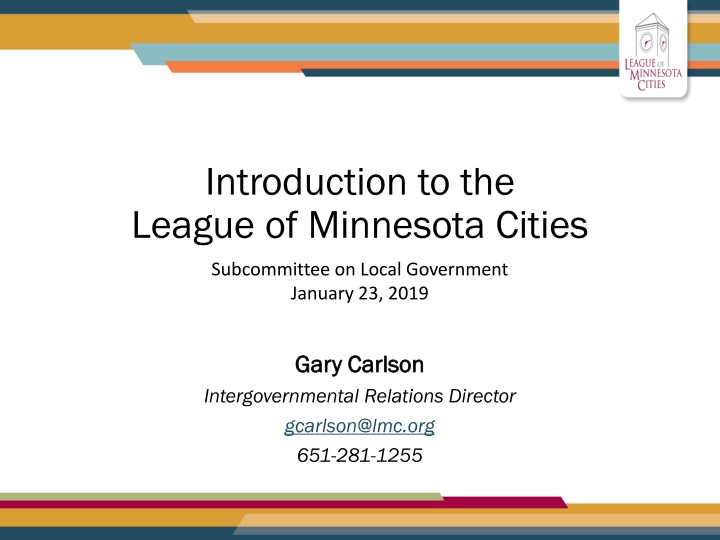
League of Minnesota Cities: Advocating for Excellence in Local Government
The League of Minnesota Cities is dedicated to promoting excellence in local government through advocacy, analysis, and guidance for cities across Minnesota. Learn about city classifications, populations, and the services provided by the League. Explore legislative issues and how the League addresses them.
Download Presentation

Please find below an Image/Link to download the presentation.
The content on the website is provided AS IS for your information and personal use only. It may not be sold, licensed, or shared on other websites without obtaining consent from the author. If you encounter any issues during the download, it is possible that the publisher has removed the file from their server.
You are allowed to download the files provided on this website for personal or commercial use, subject to the condition that they are used lawfully. All files are the property of their respective owners.
The content on the website is provided AS IS for your information and personal use only. It may not be sold, licensed, or shared on other websites without obtaining consent from the author.
E N D
Presentation Transcript
Introduction to the League of Minnesota Cities Subcommittee on Local Government January 23, 2019 Gary Carlson Gary Carlson Intergovernmental Relations Director gcarlson@lmc.org 651-281-1255
The League of Minnesota Cities promotes excellence in local government through effective advocacy, expert analysis, and trusted guidance for all Minnesota cities. Founded in 1913 by the Legislature Until 1974, the League was a part of the University of Minnesota Extension Service 833 of Minnesota s 853 cities are members of the League of Minnesota Cities
Minnesota Cities by Population (Based on 2017 Estimates) 600 532 500 400 300 200 105 92 82 100 42 0 100 and under 101 to 2,500 2,501 to 5,000 5,001 to 25,000 Greater than 25,000
City Classification Minn. Stat. 410.01 First class: First class: Cities with more than 100,000 inhabitants Once a city is in the first class, it is not reclassified unless its population decreases by 25% from the census figures that last qualified the city as first class. Second class: Second class: Cities with a population between 20,001 and 100,000 Third class: Third class: Cities with a population between 10,001 and 20,000 Fourth class: Fourth class: Cities with not more than 10,000 inhabitants
Statutory and Charter Cities Ch. 410 - 414 Within each class, a city may be a statutory city, organized and operating under state statutes, or a home rule charter city, organized and operating as provided in the charter approved by the voters of the city. Classification of Cities, House Information Brief, 2018 2017 Estimate Population of Statutory and Charter Cities Statutory Population Charter Population 1st Class 4 936,041 2nd Class 27 1,043,724 24 990,255 3rd Class 20 279,946 20 319,267 4th Class 699 826,664 59 228,725 Total 746 2,150,334 107 2,474,288
League of Minnesota Cities Services League of Minnesota Cities Services Insurance Trust--Property/Casualty/Workers Compensation coverages Research and Inquiry Amicus Program Training Conferences Intergovernmental Relations Human Resources 4M Fund (investment of public funds) Policy Analysis
Legislative Issues Legislative Issues Environment & Water Human Resources & Employment Elections Transportation Pensions & Retirement Property Tax System & Public Finance State Bonding Data Practices Economic Development Public Safety Local Control Broadband Land Use, Annexation and Zoning Housing Open Meeting Law Utilities
League of Minnesota Cities Intergovernmental Relations (IGR) Staff League of Minnesota Cities Intergovernmental Relations (IGR) Staff Follow the League IGR Team on Twitter at #lmcleg Gary Carlson Director gcarlson@lmc.org Anne Finn Assistant Director afinn@lmc.org Daniel Lightfoot Representative dlightfoot@lmc.org Craig Johnson Representative cjohnson@lmc.org Irene Kao Counsel ikao@lmc.org Ann Lindstrom Representative alindstrom@lmc.org
